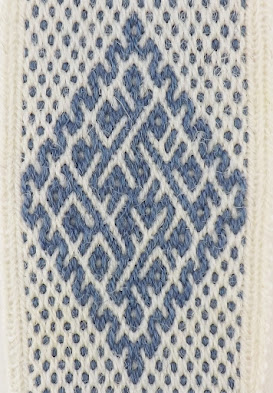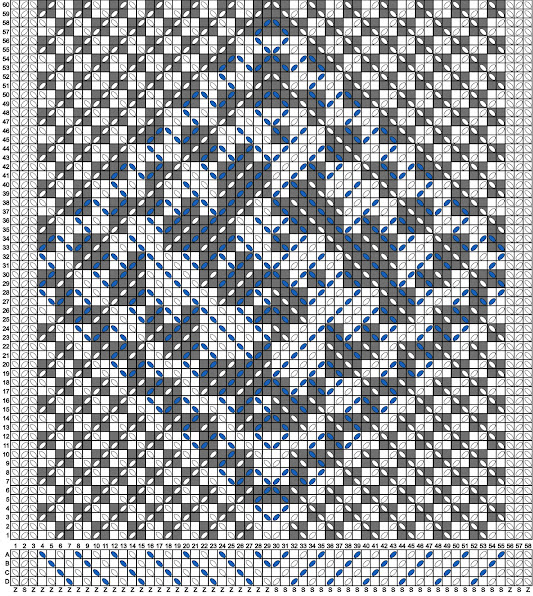This draft is from one of the two bands I designed based on V&A 838-1894 for my book Tablet Weaving in Theory and Practice: Golden Diagonals. You can find a further eighteen drafts that that use the same threading diagram in the section on V&A 838-1894 in the book, as well as eighteen for its companion band. Golden Diagonals is an exploration of 11th century to 14th century gold brocaded bands (known as orphreys) from certain types of vestments. There a total of 15 bands in the book, based on 8 extant objects: the chasuble of St. Vitalis, the chasuble of St. Wolfgang, the chasuble of St. Heinrich, fragments of a chasuble orphrey cross, V&A 1256-1864, V&A 838-1894, the Hildesheim cope, and the orphrey of abbot John Dygon. I've translated many of the motifs into other tablet woven structures: warp-twining, simple double-face, warp-floats, threaded-in, Icelandic vacant-hole, and two-hole weaving, as well as including two bands in the brocade of the originals.
I wove the sample for this band (Band 11 of the book) in King Cole Merino Blend 4-ply wool yarn in the colours mustard yellow, white, and blackcurrant purple, with additional blackcurrant purple yarn as my weft.
This orphrey fragment is held by the Victoria & Albert Museum, UK, but is no longer associated with a specific vestment. Unfortunately, this is not unusual, due to the re-tailoring and conservation process that many vestments have been through and the practice of retaining the ornaments when the accompanying garment itself is beyond use. A second fragment (inventory number: MT 35053) of this band survives and is held by the Musée des Tissus, France. They have been dated to 1100-1299 by the V&A or, more specifically, the 13th century by the Musée des Tissus. It is believed that they were woven in Sicily, Italy[1], although the V&A identifies its fragment as German, which may be more of an indication of where it was used as an orphrey as part of a vestment.
The Musée des Tissus fragment is 113mm wide and 510mm long; the V&A fragment is a little longer, as the final quarter of the motif section at the bottom edge of the Musée des Tissus piece is cut off. The original orphrey was woven using 160 square tablets, threaded in all four holes with a fine 2-ply silk thread, now beige-coloured with hints of rose[1] and a rose silk main weft. The tablets were set up in an alternating threading and turned continuously together in the same direction. There is no evidence[2] that their turning direction was reversed during weaving, but this may not be representative of the original band as a whole.
The V&A fragment has 6 lozenges containing either 4 fleurs-de-lis or a spiralling motif, against either a green or beige background, decorated with angular vines with either flowers or buds. The background of each section is filled with small brocaded diamonds. Each motif section is 140mm long[2] and is formed by brocade threads in beige, green, brown, red, and purple silks, with spun gold and silver threads with cream silk cores, used doubled. The back of the band shows that the brocade threads were used economically, passing along the back when not needed. It would have been complex to weave, as multiple different colours of brocade weft were in use at a time and they each appear to have been wound on enough shuttles to allow them to be used only in localised areas, without them needing to pass across the space between motifs.
I adapted this band (Band 11 of Golden Diagonals) from the motifs on the V&A fragment of the orphrey, alongside it sister band (Band 10). They both have the same motifs, but for 67 tablets (Band 10) and 34 tablets (Band 11). The orphrey fragment has a total of three spiralling motifs, so I separated them into centres and frames, then recombined them to give a total of nine motifs. I then designed another three frames which give us another nine motifs, when combined with the centres. I had a lot of fun with these two bands, especially the part where I was translating the motifs for half as many pattern tablets.
You can download the TDD file for this draft by clicking here.
You can download the text version of this draft by clicking here.
References
[1] Spies, N. (2000). Ecclesiastical Pomp and Aristocratic Circumstance: A Thousand Years Of Brocaded Tabletwoven Bands, Arelate Studio.


.jpg)



